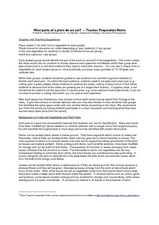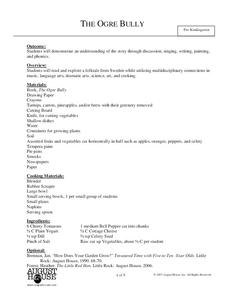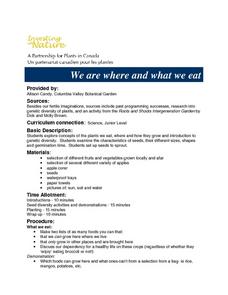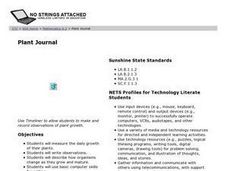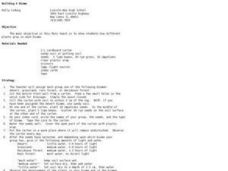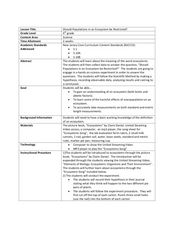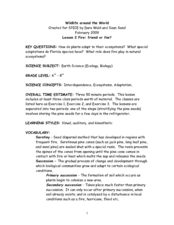Curated OER
Flowers, Pods, and Seeds
Students gain an understanding of living organisms. the complete a plant growth data log to chart plant growth and to make observations, predictions, and personal reflections.
Curated OER
Which Parts of a Plant Do We Eat?
Students identify the different parts of a plant. In this biology instructional activity, students examine its internal parts by dissecting it. They report their findings in class.
Curated OER
Our Changing Environment-- A Demonstration
Middle schoolers observe and describe changes in an environment when some of the components are changed. They recognize the process of succession by
preparing a miniaturized environment in which a variety of plants and seeds are grown.
Curated OER
The Ogre Bully
Students listen to the book, The Ogre Bully, and discuss the problems the farmer and his family had during the story. For this garden themed lesson, students examine different fruit and vegetables and plant them in soil to...
Curated OER
Rice Farming in Texas
Third graders explore how rice farming came to Texas. For this rice farming lesson, 3rd graders discover the history of how farmers began to grow rice in the United States. Students color code maps and create a timeline for rice farming...
Curated OER
6: Parts of a Flower
Students draw and label the parts of a flower using a coin from the Northern Mariana Islands. In this flower parts lesson, students look at a transparency of the reverse side of a quarter from the Mariana lslands. They discuss the...
Curated OER
Flower Power
Young scholars investigate and explain the basic needs and life processes of plants. Key concepts include: living things change as they grow and need food, water, and air to survive. The reverse of the Kansas quarter serves as inspiration.
Curated OER
Salinity Of Soil
Fourth graders investigate the contents of various types of soil to determine the differences in salinity levels. They conduct an experiment of observing the plants in the different soils. Students then determine survival rates by...
Curated OER
Plant Reproduction
Students investigate seeds and plant life by creating a germination chamber. In this botany lesson, students investigate the relationship between flowers and the fruit they produce while examining the structure of the flower. ...
Curated OER
Observing Root Response After Rotating Plant Ninety Degrees
Students conduct an experiment to observe the response of maize roots when rotated 90 degrees.
Curated OER
We are where and what we eat
Students explore concepts of plants they eat, where and how they grow and are introduced to genetic diversity. They examine seed characteristics, look at their different sizes, shapes and germination time. They also set up seeds to...
Curated OER
Archaeobotany
Students study pictures of seeds and the conditions in which they grow during their study of archaeobotany. They infer ancient plant use by looking at archaeobotanical samples. They determine the change of plant use by interpreting a...
Curated OER
Dune Plan Adaptations
Students tour Coal Oil Point Reserve. They locate the species of plants that are on the handouts ,and describe the different adaptations used by plants in their specific area of the dunes.
Curated OER
Using the Scientific Method to Determine Which Conditions Best Favor Plant Growth
Seventh graders examine how the environment can affect biological processes. They identify the best conditions for the germination of bean seeds. They record and analyze their data. They write about their observations in an essay.
Curated OER
Plant Journal
Students measure the daily growth of plants in this technology-based science instructional activity that uses Timeliner to record student data. The instructional activity allows students practice at basic computer skills (typing/data...
Curated OER
Parts of a Plant
Students record observations about parts of plants including leaves, roots, stems, and flowers. They use Kid Pix to draw a picture of a plant and to label the parts of the plant.
Curated OER
Sunny Sunflowers
First graders, after assessing how plants grow in relation to light, create models of sunflowers within a game to help them remember their science instructional activity. In addition, their visual models serve as a demonstration of photo...
Curated OER
Building a Biome
Students investigate how plants grow in different biomes. In this biomes lesson plan, students plant sees of impatiens, lima beans and rye seeds in egg cartons. When the plants begin to grow they simulate the assigned biome conditions...
Curated OER
The Wheat Plant
Students sequence stages in the life of a wheat plant. They identify the six main parts of the wheat plant. They plant some kernels of wheat in the classroom so students can watch the growth and development. They record the plant's...
Curated OER
Now You Have It, Now You Don't
Students compare shipping peanuts made from corn and made from Styrofoam. In this corn based peanuts lesson plan, students understand why to use eco-friendly materials for packing. Students participate in an experiment to compare the...
Curated OER
A Field of Beans
Beans, or legumes as they are sometimes called, are the topic for an integrated multi-subject lesson. Youngsters will read, write, observe, and research everything there is to know about beans. They read a bean story, conduct a bean...
Curated OER
Should Populations in an Ecosystem be Restricted?
Fourth graders experiment to determine how overpopulation effects ecosystems specifically plants. In this ecosystem lesson, 4th graders conduct an ecosystems experiment after listening to Claire Daniel's, Ecosystems. They watch a video,...
Curated OER
Wildlife Around the World
Students examine how plants are able to adapt to their ecosystem and the role that fire plays in changes through the years. In this ecosystem lesson students complete several exercises focussing on plants and their adaptations to.
Curated OER
Pumpkins . . . Not Just Part of Halloween
Students study the pumpkin. In this pumpkin lesson, students participate in different activities that explain the history of pumpkins and how pumpkins develop and grow, read "The Great Pumpkin Story" and answer comprehensive questions...



